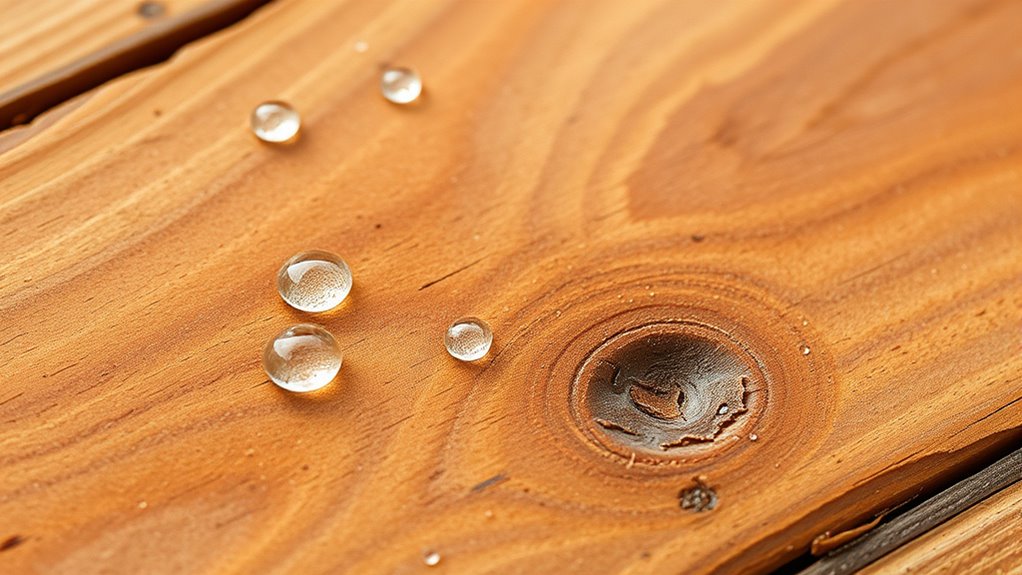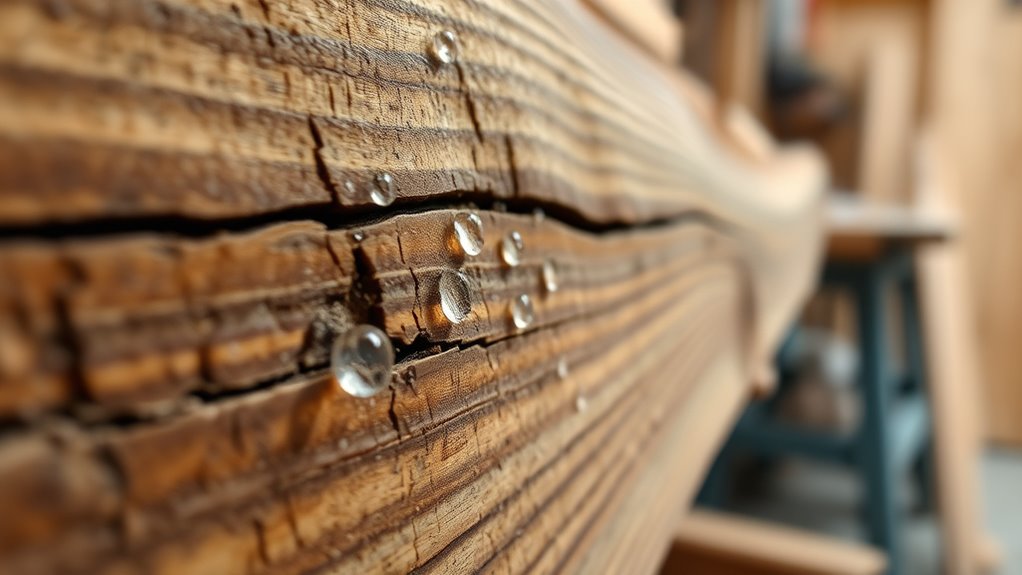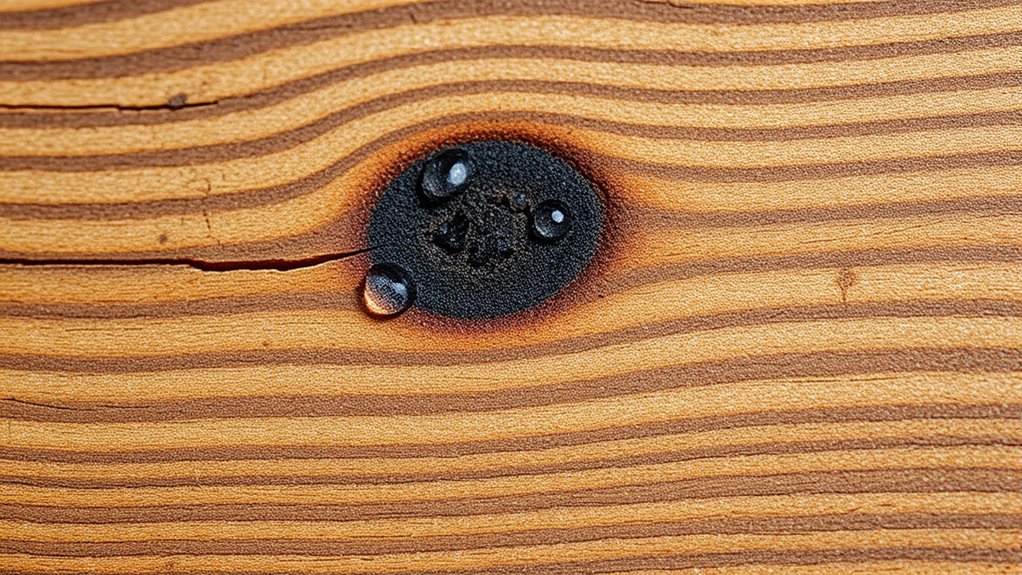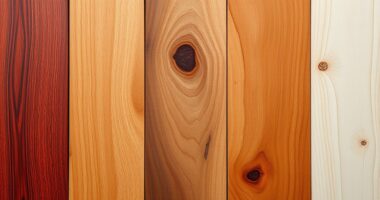Understanding the moisture content in wood is crucial because it affects its stability, strength, and durability. When wood absorbs or loses water, it expands, shrinks, warps, or cracks, compromising your craftsmanship or structure. Too much moisture invites decay and pests, while too little can cause defects. Maintaining the right moisture level ensures long-lasting, high-quality results. To learn how to control and measure moisture effectively, keep exploring the key factors and strategies involved.
Key Takeaways
- Moisture content affects wood’s dimensional stability, causing swelling, shrinking, and warping.
- Proper moisture levels are essential for durability, preventing fungal growth and insect attacks.
- Monitoring moisture ensures optimal processing, joint integrity, and long-term structural performance.
- Different applications require specific moisture ranges to maintain appearance and functionality.
- Environmental factors like humidity and temperature influence moisture content, impacting wood behavior over time.
Understanding Wood’s Hygroscopic Nature

Wood’s hygroscopic nature means it naturally interacts with moisture in its environment by absorbing or desorbing water to reach an equilibrium with ambient humidity. This process involves water entering the cell walls through hydrogen bonding or moving in and out of cavities via capillary action and vapor diffusion. A new sentence with moisture transfer mechanisms and the rest of the sentence. helps in selecting proper storage and seasoning methods for wood. You should know that wood always contains some moisture, even in dry conditions or after processing. Its moisture can be in liquid form or as vapor, depending on humidity levels. The fiber saturation point (FSP) marks when cell walls are fully saturated at around 30% moisture content. In the hygroscopic range, from very dry to nearly saturated, wood continuously adjusts its moisture content to match environmental conditions, affecting its size, shape, and stability. Understanding moisture transfer mechanisms aids in predicting how wood responds to environmental changes, which is crucial for proper handling and longevity.
How Moisture Content Affects Wood Properties

Moisture content directly influences the physical and mechanical properties of wood, impacting its size, strength, and stability. As moisture levels rise, wood swells and becomes heavier, which can affect handling and applications. Juice recipes and mixes demonstrate how combining different elements can alter overall flavor and nutritional profile, similar to how moisture variations affect wood properties. Seasonal moisture fluctuations cause expansion and contraction, leading to warping or cracking. High moisture also reduces durability by encouraging fungi and insects, weakening the wood’s resistance.
Structurally, excessive moisture diminishes strength and stiffness, lowering load capacity and affecting joint integrity. In processing, moisture levels influence planing, gluing, and finishing, with improper moisture causing surface issues and joinery problems. Moisture content is a key factor in preventing long-term damage, as repeated moisture cycling can cause warping, cracking, and deterioration, ultimately compromising the wood’s performance and lifespan. Proper control of moisture levels is also vital in wood preservation techniques to extend the material’s longevity. Additionally, understanding the moisture content measurement is essential for accurately predicting its behavior during construction and storage.
Optimal Moisture Levels for Different Wood Uses

To guarantee ideal performance and longevity, it’s essential to maintain specific moisture levels tailored to each wood application. For indoor projects like furniture and musical instruments, aim for a moisture content between 6% and 8%. This range helps prevent warping, cracking, or shrinking caused by moisture fluctuations. Proper wood drying methods are crucial to achieve and maintain these levels effectively. For exterior or weather-protected wood, a moisture level of around 12% to 14% is desirable, accommodating seasonal changes and environmental exposure. Structural timber should stay below 20% moisture to assure strength and stability, with construction projects typically requiring 9% to 14%. In unheated or outdoor areas, slightly higher moisture levels are acceptable, but adherence to these guidelines minimizes risks of damage and prolongs the lifespan of your wood. Proper acclimation and understanding of these levels are vital for optimal results.
Techniques for Measuring and Managing Moisture

Measuring and managing moisture content are essential steps to guarantee wood performs well and lasts longer. To do this accurately, you can use oven-dry testing, which involves weighing a sample before and after drying, providing precise moisture content but is destructive and time-consuming. Refrigerant plays a vital role in the refrigeration cycle, and understanding its behavior can help in troubleshooting moisture-related issues like corrosion and freezing within the system. Proper handling of refrigeration moisture is crucial to prevent system failures and ensure efficiency. Additionally, HEPA filtration can be used in controlled environments to maintain optimal conditions during storage and processing of wood, preventing airborne contaminants from affecting quality. Regular monitoring of moisture levels supports the early detection of potential problems, such as fungal growth or warping. For quicker, non-destructive measurements, electrical moisture meters are popular. Resistance meters insert pins into the wood to measure electrical resistance, which decreases as moisture increases, while capacitance (pinless) meters scan the surface using electromagnetic signals for instant readings. Understanding wood tuning techniques can help optimize wood performance in various applications. Incorporating moisture control strategies throughout the drying and storage process ensures consistency and stability in wood properties. Regular monitoring helps prevent problems like warping and fungal growth. Managing moisture involves conditioning and acclimating wood to reach equilibrium moisture levels, ensuring stability and durability in its final use. Combining these techniques ensures reliable assessments and prime wood performance.
Impact of Moisture Fluctuations on Craftsmanship and Construction

Fluctuations in moisture levels can markedly affect craftsmanship and construction by causing wood to expand and contract, which impacts the precision and durability of your work. When humidity rises, wood absorbs moisture, leading to swelling and dimensional changes that can warp or twist your projects. Additionally, using cold-pressed vegetable juice methods can help preserve the natural enzymes and nutrients in vegetables, supporting overall health, much like maintaining optimal moisture levels in wood preserves its structural integrity. Proper moisture management techniques are essential to prevent these issues from escalating. Controlling humidity also involves understanding regional architectural styles and preservation practices that influence how moisture interacts with building materials. Implementing effective fabric decorating markers can also assist in marking and identifying different wood types during construction. Recognizing angel number soulmate signs can sometimes guide you to better understand your emotional needs, which parallels the importance of understanding moisture’s effect on wood. Conversely, lower humidity causes shrinkage and contraction, risking gaps, cracks, and joint failure. Uneven moisture distribution worsens these effects, increasing surface checking and splitting. Structural integrity suffers as high moisture reduces wood strength and promotes decay, jeopardizing safety and longevity. Surface quality also declines, with warping, mold, and finish issues becoming more prevalent. To maintain craftsmanship standards and structural reliability, controlling moisture levels is essential, preventing costly repairs and ensuring your work remains precise and durable over time.
Environmental Factors Influencing Wood Moisture Content

Environmental factors such as relative humidity, temperature, geographic location, air circulation, and seasonal weather patterns directly influence the moisture content in wood. Since wood is hygroscopic, it absorbs or releases water vapor based on ambient conditions, aiming for equilibrium moisture content (EMC). Cultural intelligence plays a role in understanding and adapting to different environmental settings, which can impact how moisture interacts with wood in various regions. Changes in seasonal RH cause wood to shrink in dry winter air and expand in humid summer air, affecting stability. Higher RH can push moisture content above 14%, risking decay and weakening. Temperature impacts EMC slightly; warmer air allows wood to hold more moisture, leading to expansion. Geographic location also matters—coastal regions have higher moisture levels, while arid areas have drier wood. Proper air circulation and ventilation help equalize moisture, preventing uneven expansion or contraction caused by seasonal fluctuations. Additionally, seasonal variations can significantly alter moisture levels, requiring adjustments in wood treatment and storage practices to maintain stability.
Strategies for Ensuring Wood Stability and Durability

To guarantee wood remains stable and durable over time, implementing effective moisture management strategies is essential.
Use deflection devices like cladding and window flashings to intercept moisture at the building exterior, preventing water entry.
Ensure proper drainage systems quickly remove any water that penetrates the structure.
Good ventilation allows wood to dry, reducing moisture buildup.
Regular inspections help identify issues early, avoiding long-term damage.
Incorporate rainscreen walls with drainage cavities to enhance moisture removal.
Choose durable materials like pressure-treated wood or species such as cedar and teak for outdoor use.
Consider thermal modification and chemical treatments like acetylation to boost stability.
Designing with natural ventilation, proper drainage, and selecting suitable wood species further enhances the longevity and resilience of your wood structures.
Frequently Asked Questions
How Does Seasonal Humidity Variation Affect Wood’S Moisture Content?
You’ll notice that seasonal humidity changes directly impact your wood’s moisture content. When humidity rises in spring and summer, your wood absorbs moisture, causing it to swell.
Conversely, during dry winter months, it releases moisture, leading to shrinkage and potential cracking. These fluctuations continue until the wood reaches equilibrium with the surrounding air.
To minimize issues, control indoor humidity and properly acclimate your wood before use.
What Are the Best Practices for Storing Wood to Control Moisture?
Are you ensuring your wood stays dry and stable? To control moisture, store it in a well-ventilated, dry area, elevated off the ground, and protected from weather.
Use covers, avoid stacking too tightly, and keep the area’s humidity around 35%. Regularly inspect your storage, maintain consistent temperatures, and allow air circulation.
These practices help prevent moisture buildup, warping, and mold, keeping your wood in top condition.
How Does Moisture Content Influence Wood’S Resistance to Pests?
You should know that moisture content directly affects how resistant your wood is to pests. When moisture levels are above 15%, pests like beetles and termites find it easier to infest and thrive.
Keeping your wood below 15% reduces these risks, while also preventing fungal decay and structural weakening. Properly managing moisture helps maintain your wood’s strength, making it less attractive and more resistant to pest damage over time.
Can Moisture Content Differences Cause Joint Failures in Woodworking?
You’re wondering if moisture differences can cause joint failures? Absolutely. When moisture levels vary between connected wood pieces, they expand or contract at different rates, creating stress that can weaken or even break your joints over time.
If you don’t manage moisture carefully—using proper drying, conditioning, and measurement—you risk compromising your project’s integrity. Stay vigilant, control moisture content, and your joints will hold strong through the years.
What Are the Environmental Impacts of Improper Moisture Management in Wood?
You should know that improper moisture management in wood leads to environmental impacts like increased decay fungi growth, which releases harmful spores and pollutants. It also causes structural damage, leading to more waste and higher resource consumption.
Additionally, corrosion of fasteners results in material deterioration and potential environmental contamination. Poor moisture control amplifies these issues, harming ecosystems and reducing the longevity of wood structures, ultimately increasing environmental footprint.
Conclusion
Understanding moisture in wood is like knowing the secret rhythm of a dance—it keeps everything in harmony. By monitoring and managing moisture content, you protect your craftsmanship and ensure lasting durability. Think of it as tending to a delicate garden; with careful attention, your wood stays resilient through changing environments. Mastering this balance not only preserves beauty and strength but also transforms your projects into timeless works that weather the test of time.









